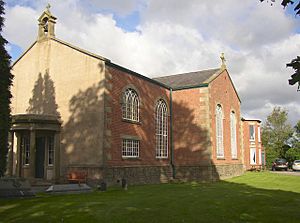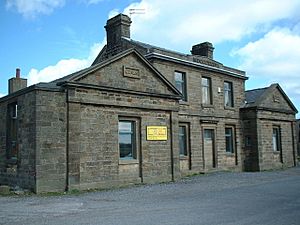St Mary's Church, Fernyhalgh facts for kids
Quick facts for kids St Mary's Church, Fernyhalgh |
|
|---|---|

St Mary's Church and presbytery from the southwest
|
|
| Lua error in Module:Location_map at line 420: attempt to index field 'wikibase' (a nil value). | |
| OS grid reference | SD 554 341 |
| Location | Fernyhalgh Lane, Broughton, Lancashire |
| Country | England |
| Denomination | Roman Catholic |
| Website | St Mary, Fernyhalgh |
| Architecture | |
| Functional status | Active |
| Heritage designation | Grade II |
| Designated | 11 November 1966 |
| Architectural type | Church |
| Groundbreaking | 1792 |
| Completed | 1794 |
| Administration | |
| Diocese | Lancaster |
St Mary's Church is a Roman Catholic church located in Fernyhalgh Lane, Broughton, Lancashire, England. It stands close to the Ladyewell House shrine. The church was built between 1792 and 1794. It became necessary because the small chapel at Ladyewell House could no longer hold all the people visiting the shrine.
The church and the presbytery (the house where the priest lives) are made of red brick with stone details and slate roofs. A school, built in 1836, is also nearby. Ladyewell House holds a 16th-century altar, special religious items called relics, and other important objects. In its garden, there is a chapel and a holy well. Today, both the church and the house are still used for church services, pilgrimages, and welcoming visitors.
Contents
History of St Mary's Church
Fernyhalgh has been a place for Christian worship since the 11th century. This became even more important after the Reformation, a time when the Church in England changed. The house with the shrine was rebuilt in 1685, and from then on, it was known as Ladyewell.
A woman known as "Dame Alice" ran a school nearby. Over 100 students attended her school and visited the shrine and church every day. Her school welcomed students of all Christian faiths, but it was mainly for Catholic children.
By the late 1700s, the chapel at Ladyewell House was too small for the many pilgrims who came to visit. So, people decided to build a larger church. They bought land about 0.25 miles (0.4 km) away. The church and the presbytery were built from 1792 to 1794. This happened soon after the Roman Catholic Relief Act 1791 was passed. This law gave Catholics more freedom to practice their religion.
Around 1844–1847, the inside of the church was beautifully painted and decorated by Andrew Carter from Preston. Stained glass windows were also added at this time.
Exploring the Church Building
Outside the Church
St Mary's Church is built from red brick. It has a stone base and stone details. The roof is made of slate, with stone edges along the gables (the triangular parts of the wall at the end of a pitched roof). The church has a cross-shaped design. It has five main sections, called bays, and two-bay transepts (parts that stick out like arms of a cross) on the north and south sides.
Each bay has a large, round-topped window with a stone arch. The window at the west end is split into two parts because of a gallery inside. The front of the church, facing west, is covered in a smooth plaster. It has a small bell tower on the gable and a round porch with simple columns.
Inside the Church
Inside, there is a gallery at the west end, supported by simple, sturdy columns. The arches in the transepts are round-topped and have painted undersides. The ceiling is flat. There is an oval-shaped arch leading into the sanctuary, which is the sacred area around the altar.
The reredos, a screen behind the altar, has decorative columns that are richly painted and gilded (covered in gold). It features round designs and a central diamond shape with an image of the Virgin Mary. Above the reredos, there is a painted dome in deep blue with gold stars and a picture of a dove. The altar rail is made of alabaster, a soft, white stone, and was likely added in the late 1800s. The statues in the church were made by Mayer of Munich. The stained glass windows were installed in 1854 by Andrew Carter.
You can also find monuments inside. One is for Catharine Hesketh, a nun who passed away in 1809 and became the head of a convent in Ghent. On the floor, there are special brass plaques that remember the priests who served the church in the 1800s.
The Presbytery
The presbytery, the priest's house, is connected to the east end of the church. It is also built with red brick, stone details, and a slate roof. It has two floors and two sections. In one section, there is a later bay window that sticks out. There is also a doorway that was moved into a newer extension built in the 1900s. Some of the original features inside the presbytery have been kept.
The School Building
The school building is located to the west of the church. Father Richard Gillow, who was the priest at the time, paid for its construction. It was built in 1836 and is made of sandstone with slate roofs. The school has a balanced, H-shaped design. It has a main two-story section with three bays and single-story wings on each side, also with three bays and gabled roofs.
The main entrance in the center has a decorative frame and a flat top. The windows are rectangular, though their glass has been changed over time. At the top of the main section, there is a low wall with a triangular part in the middle. This triangle shows the year the school was built in Roman numerals. The triangular parts on the side wings have stone tablets that say "GIRLS" and "BOYS."
The Ladyewell Shrine
Inside Ladyewell House, you can find the Burgess altar, which was made in 1560 by a Mr. Burgess. The house also contains many relics and items related to Christian martyrs (people who died for their faith). The most important relics are those of Thomas à Beckett, which have been confirmed as real.
In the garden of Ladyewell House, there is the English Martyrs Chapel and a holy well. In the nearby woods, you can follow the Stations of the Cross, which are a series of images showing events from the day Jesus died.
Importance of the Buildings
St Mary's Church was given a special status as a Grade II listed building on November 11, 1966. The school received the same status on January 13, 1986. Grade II is the lowest of the three listing grades. It means the building is "of special interest" and should be protected.
St Mary's Church Today
St Mary's is still an active church within the Diocese of Lancaster. Mass (church services) is held in both the church and Ladyewell House at specific times. Ladyewell House is open for visitors during the week. Many pilgrimages, which are special journeys for religious reasons, often take place to the church and house. The old school building has been changed and is now used as a nursery and a community center for the church.
See also
- Listed buildings in Broughton, Lancashire
- Shrines to the Virgin Mary


